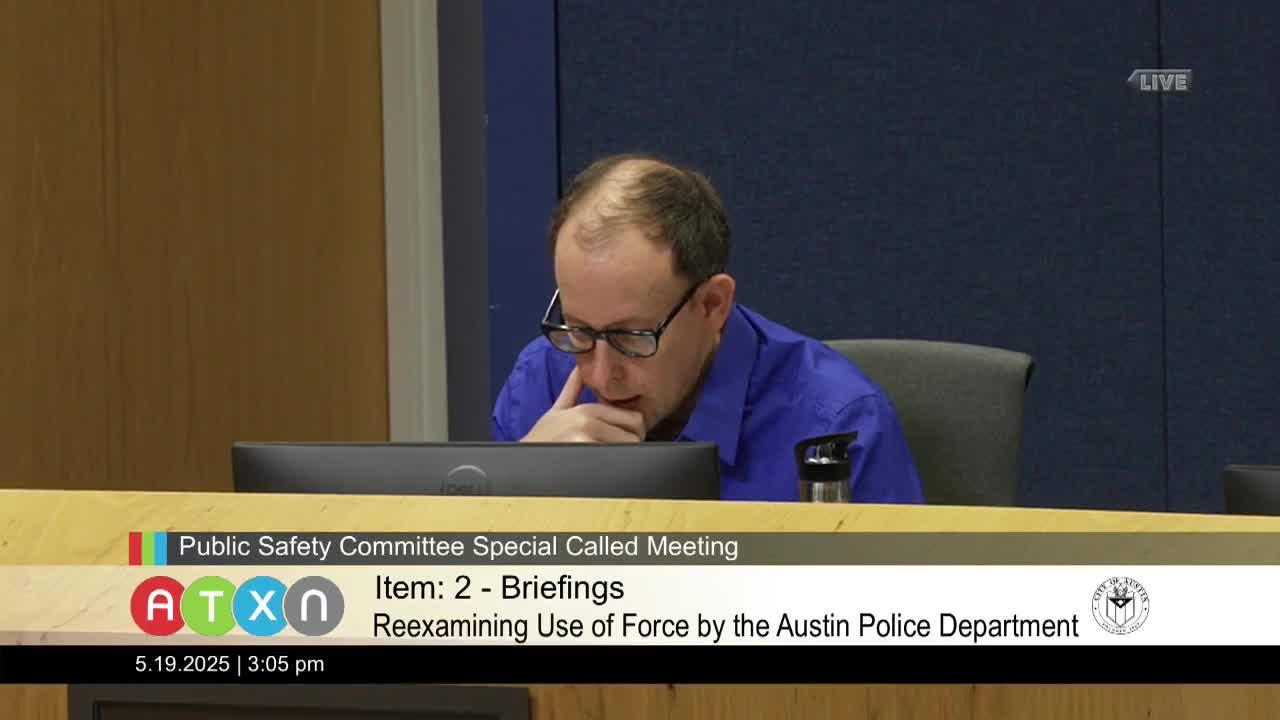Austin police reevaluate use of force reporting standards amid inconsistent national guidelines
May 19, 2025 | Austin, Travis County, Texas
This article was created by AI summarizing key points discussed. AI makes mistakes, so for full details and context, please refer to the video of the full meeting. Please report any errors so we can fix them. Report an error »

In a recent meeting of the Austin Public Safety Committee, city officials delved into the complexities of policing standards and the challenges of implementing effective use-of-force policies. The discussion, marked by a sense of urgency and introspection, highlighted the need for a more standardized approach to policing that could benefit from lessons learned across various jurisdictions.
As committee members gathered, the atmosphere was charged with a desire to understand why existing models for policing seem elusive. One member raised a critical question: why is there no standardized textbook or model that Austin can adopt to navigate the challenges it faces? The response revealed a broader issue within the U.S. law enforcement landscape, where 18,000 agencies operate under inconsistent standards. This lack of uniformity complicates efforts to implement best practices, as each agency grapples with its unique set of challenges.
The conversation turned to the historical context of Austin's use-of-force reporting, particularly the controversial "level 4" incidents. Officials acknowledged that the current system, which has been in place for nearly a decade, was designed to ensure thorough reporting but may have inadvertently created confusion. The chief explained that the policy aimed to capture every possible use of force, leading to an overwhelming number of reports that may not accurately reflect the reality of police interactions.
As the committee explored potential reforms, concerns about resistance to change emerged. Some members expressed apprehension that those accustomed to the existing reporting methods might resist new approaches. However, the chief emphasized the importance of inclusivity in the reform process, advocating for a task force that would bring together diverse perspectives to ensure that any changes made would enhance safety for both officers and the public.
The meeting underscored a pivotal moment for Austin's policing strategies, as officials recognized the need for data-driven reforms that are not merely reactions to public outcry but are grounded in research and best practices. As the city moves forward, the challenge will be to balance the need for accountability with the complexities of policing in a diverse community. The discussions at this meeting may very well shape the future of public safety in Austin, as officials strive to create a more effective and transparent policing model.
As committee members gathered, the atmosphere was charged with a desire to understand why existing models for policing seem elusive. One member raised a critical question: why is there no standardized textbook or model that Austin can adopt to navigate the challenges it faces? The response revealed a broader issue within the U.S. law enforcement landscape, where 18,000 agencies operate under inconsistent standards. This lack of uniformity complicates efforts to implement best practices, as each agency grapples with its unique set of challenges.
The conversation turned to the historical context of Austin's use-of-force reporting, particularly the controversial "level 4" incidents. Officials acknowledged that the current system, which has been in place for nearly a decade, was designed to ensure thorough reporting but may have inadvertently created confusion. The chief explained that the policy aimed to capture every possible use of force, leading to an overwhelming number of reports that may not accurately reflect the reality of police interactions.
As the committee explored potential reforms, concerns about resistance to change emerged. Some members expressed apprehension that those accustomed to the existing reporting methods might resist new approaches. However, the chief emphasized the importance of inclusivity in the reform process, advocating for a task force that would bring together diverse perspectives to ensure that any changes made would enhance safety for both officers and the public.
The meeting underscored a pivotal moment for Austin's policing strategies, as officials recognized the need for data-driven reforms that are not merely reactions to public outcry but are grounded in research and best practices. As the city moves forward, the challenge will be to balance the need for accountability with the complexities of policing in a diverse community. The discussions at this meeting may very well shape the future of public safety in Austin, as officials strive to create a more effective and transparent policing model.
View full meeting
This article is based on a recent meeting—watch the full video and explore the complete transcript for deeper insights into the discussion.
View full meeting
